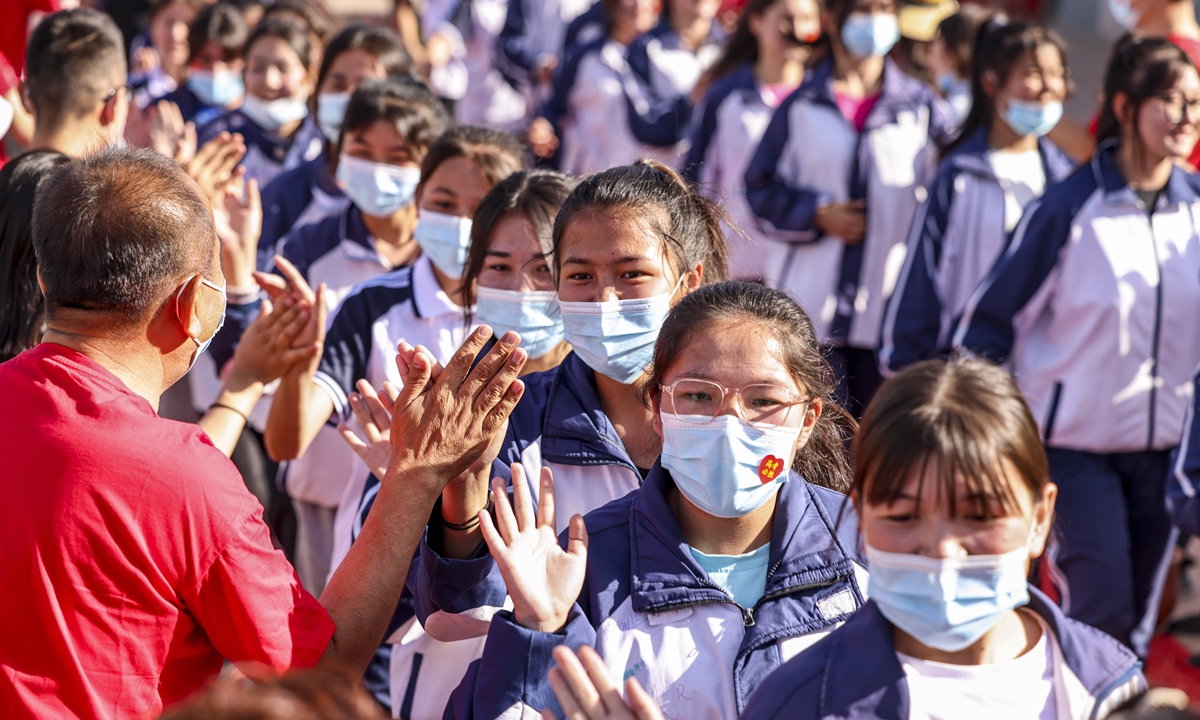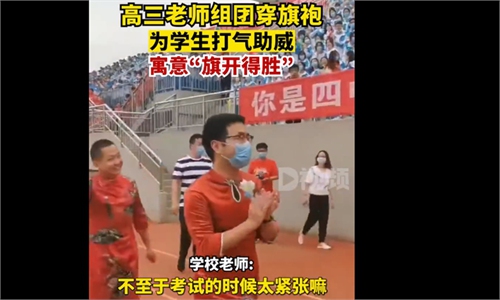Record 11.9m students to take gaokao with full preparations under shadow of COVID-19

Students in Aksu Prefecture in Northwest China's Xinjiang Uygur Autonomous Region and their teachers applaud each other on June 6, 2022. This is a gesture of cheer as the students are going to take this year's national college entrance examinations the next day. Photo: VCG
With 11.93 million students ready to take this year's national college entrance examinations, or gaokao, on Tuesday in the third year under the shadow of the COVID-19 pandemic, Chinese authorities are fully prepared to ensure smooth implementation of the most important exam of Chinese students' lives while preventing a rebound of infections.
The number of the 2022 gaokao examinees is 1.15 million more than last year, according to the Chinese Ministry of Education.
The ministry on Monday told local authorities to strengthen support services, including those related to traffic, health and safety, for test-takers and reminded the examinees to abide by local anti-epidemic policies and enhance personal protection during the exam.
It is the third year that China is holding the gaokao, which is viewed as the most important exam and a key chance for Chinese students to change their fates, amid the risk of COVID-19 infections.
In 2020, the first year of the epidemic, the exam was postponed by one month across the country. This year, the exam was postponed locally by one month only in Shanghai, China's economic hub, which just embraced a restart on June 1 after two months' fight against the Omicron variant.
As the country has just overcome severe outbreaks in Shanghai and Beijing, nationwide authorities have made full preparations for this year's exam.
"My son today uploaded his health status including a negative nucleic acid result within 48 hours based on the education authorities' requirement," a high school student's parent surnamed Zhang in Beijing told the Global Times on Monday. Zhang said the school has required all students to monitor their own health status 14 days ahead of the examination.
Zhang had some concerns due to the impact of the epidemic, but felt satisfied and relieved when seeing all the preventive measures taken by the authorities after bringing her son to check the exam site on Monday afternoon.
Beijing has made some special arrangements for epidemic-stricken students. The authorities in Fengtai district said that they had arranged 600 vehicles to provide one-on-one services to take students from areas under epidemic control to the testing sites. Another 30 vehicles have been arranged to provide emergency services for gaokao attendees in these areas.
Similar measures have been launched in other cities. A teacher from Shenzhen in South China's Guangdong Province told the Global Times on condition of anonymity that all the students taking the exam should show a negative nucleic acid result within 24 hours. Or they can show a negative nucleic acid result within 48 hours plus a nucleic acid sampling proof.
All the students underwent self-health monitoring for 14 consecutive days before the exam, the teacher said. Teachers supervising the exams are required to take nucleic acid tests every day during the exam and teachers should commute only between their homes and the exam sites, and avoid gathering, according to the teacher.
A teacher in Chongqing told the Global Times on condition of anonymity that nucleic acid testing points had been built around local high schools to help students. Local schools that would be used as testing centers also conducted disinfection in recent days.
The Global Times learned from local officials in Jiangxi that special exam rooms have been set up at local hospitals and quarantine centers for examinees who are confirmed patients, silent carriers or close contacts of the two groups. Those who fail to provide negative nucleic acid testing results would have to attend the exam in back-up or quarantine exam rooms.
An examinee in Tianjin told the Global Times on condition of anonymity on Monday that her mother came to Tianjin to accompany her a month before the gaokao and was required to stay in quarantine for 14 days. They are also required to stay in Tianjin for another week after the exam and take nucleic acid tests before they are allowed to leave the municipality.
"Three years into the pandemic, China has gained abundant experience with the virus, so we should be confident that the exam would also be carried out smoothly this year despite the delay in some places or the use of special exam rooms in some places for examinees under quarantine or who are infected," Xiong Bingqi, deputy director of the Shanghai-based 21st Century Education Research Institute, told the Global Times on Monday.
As to the increasing number of examinees, Xiong explained that it was in large part because higher vocational colleges in China have expanded enrollment.
China in 2019 launched a plan to expand vocational college enrollment and lifted the limit on the ratio of students in secondary vocational schools to enter higher schools.
Since then, the number of gaokao examinees has reportedly exceeded 10 million for four straight years. It was 9.75 million in 2018.

